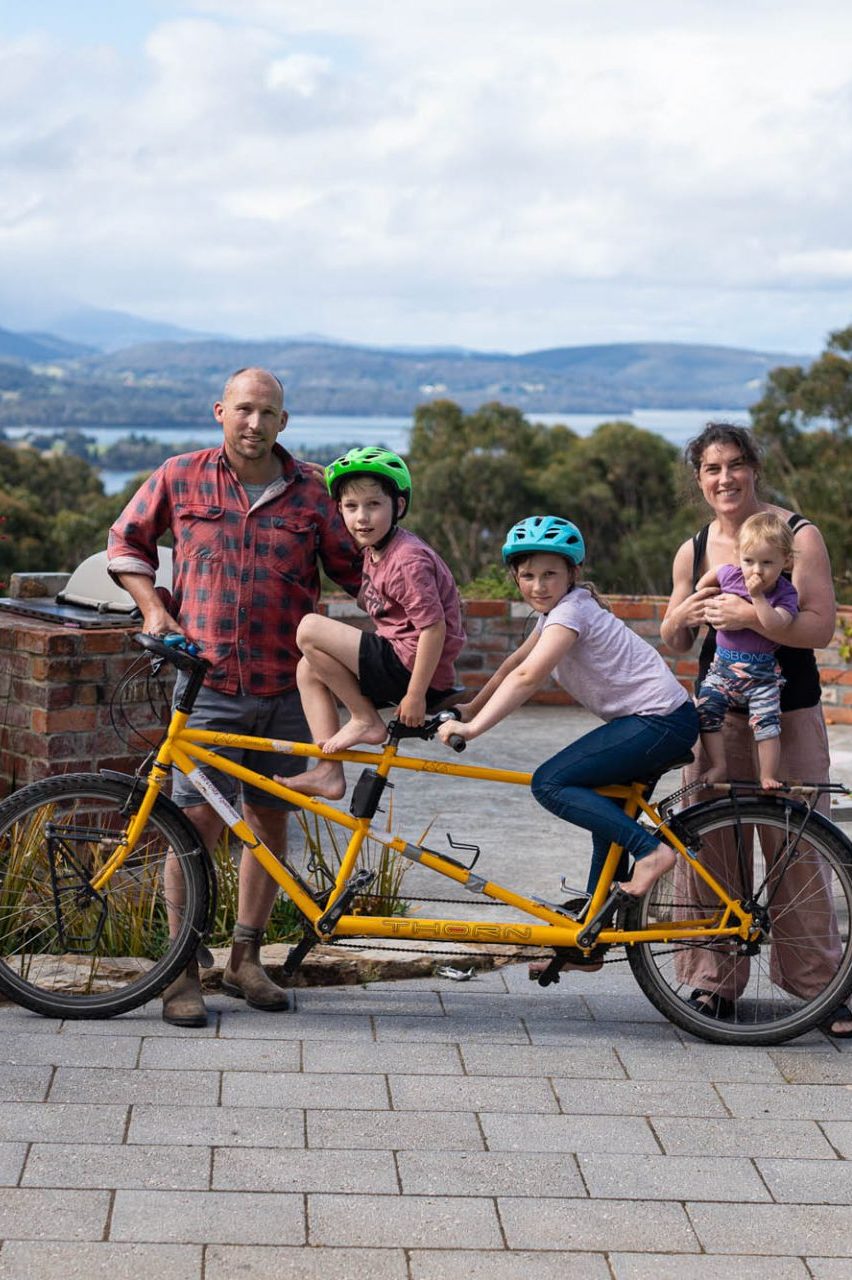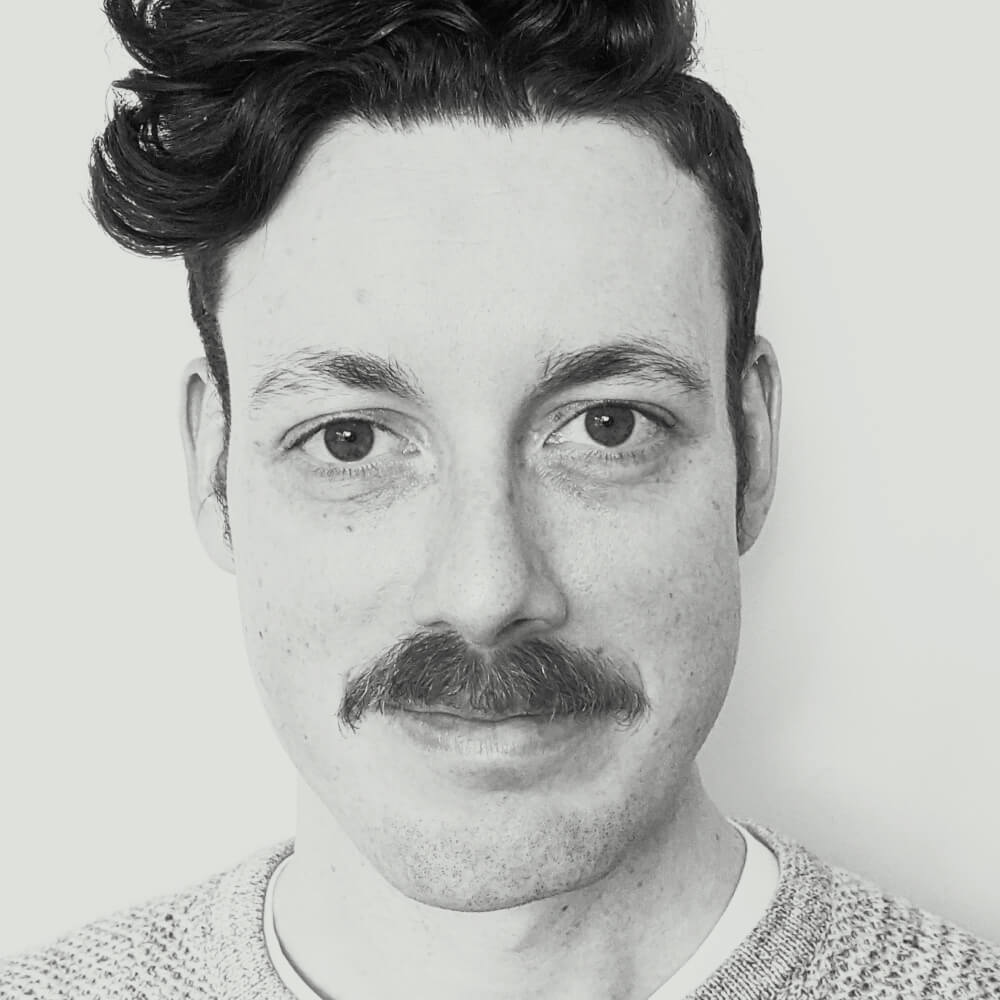Certain feats on the bike boggle the mind – fastest rides, longest rides, toughest rides – but it’s the touring cyclists that lay claim to some of the most fascinating tales. Of that crop, there’s one family that is particularly extraordinary, not because of how far they’re riding (although they’ve ridden very, very far and are about to ride even further) but because of how they’ve gone about it.
In 2019, the Hughes family – also known as the ‘Swag Family’ – rode 14,000 km around Australia, with their two children, Hope and Wilfy (five and three years of age at the time) in tow.
Almost five years after completing that – and with another child added to the mix, Jean (one and a half) – the travel bug has bitten again. This time, the Hughes family has their sights set further afield, with a world tour that they estimate will take three years.
These are the bare facts about a trip that, even before it begins, is intriguing in its scope and bravery. Curious to learn more, I jumped on a call with the two Hughes parents – Andrew and Nicola – a few days before the road becomes their family home again.
I’d initially planned to write a narrative around their responses, but they were so warm and articulate and considered in their responses – so in sync with each other, passing responses gracefully back and forth – that I really want to just run this as a straight transcript, complete with terrific pictures from their Australian tour.
These are the Hughes family’s thoughts on parenting, life at the pace of a bicycle, and the fundamental kindness of humanity.
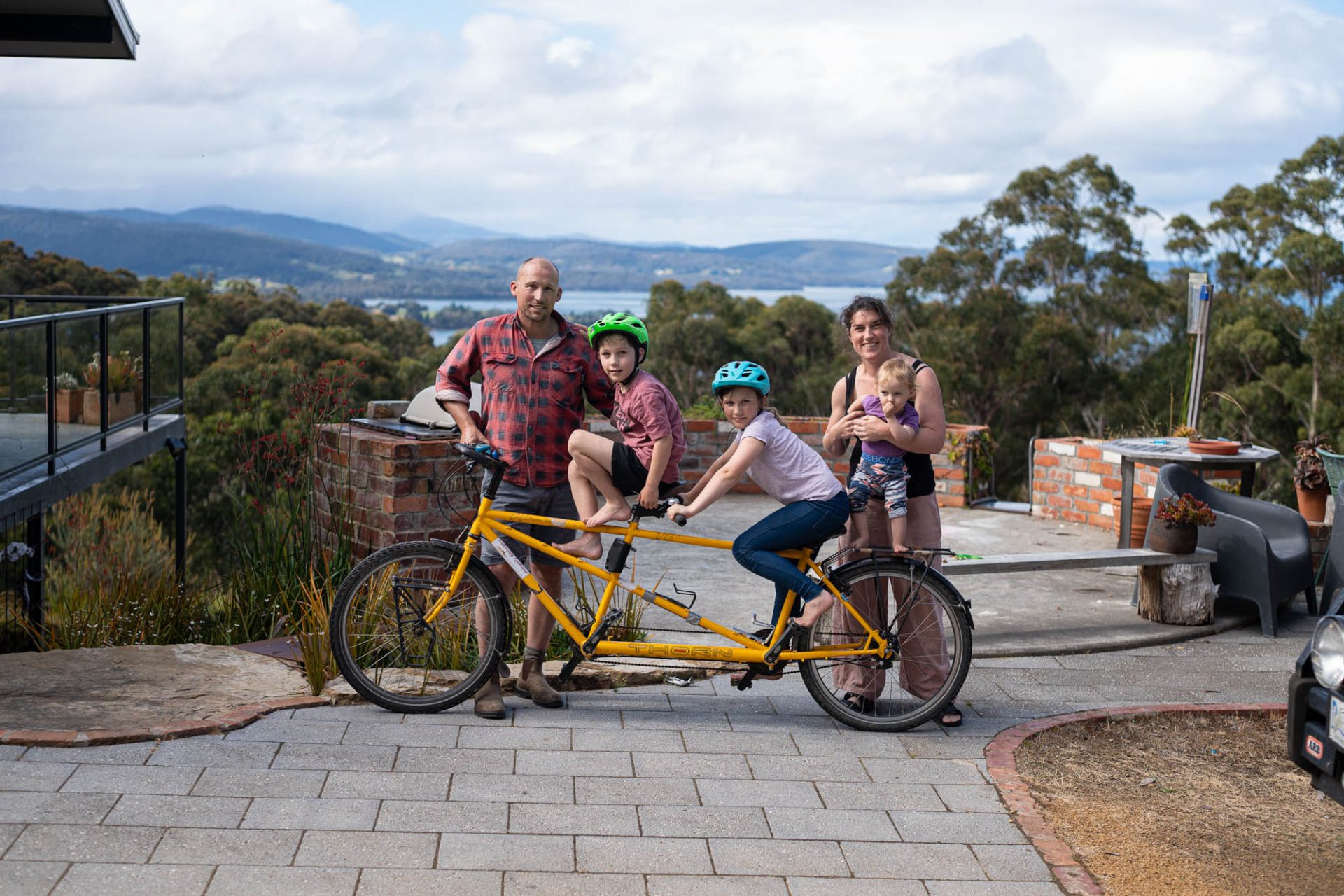
Iain Treloar: Can you introduce yourself and run me through the various members of the family and your ages – or at least the kids’ ages, I don’t need to know exactly how old you guys are …
Andrew Hughes: [laughs] There are no secrets with us. Yep, so my name is Andrew Hughes. I am 45, and I’m from Flowerpot [ed. a small town near Hobart, Tasmania]. And Nicola …
Nicola Hughes: I am 40, also from Flowerpot.
AH: And our kids: there’s Hope – she’s 10 – Wilfy – he’s eight – and Jean. She’s one and a half.
IT: That’s a big spread of ages, and I imagine a one and a half year old might be quite … challenging to travel with.
AH: [laughs] There is a question mark on that one, Iain …
NH: We’ll let you know in a couple of weeks!

IT: So Hope and Wilfy have done this before. Can you run me through your previous adventures?
AH: So back in 2019, we took 12 months, and rode on two tandem bikes from our home in Tasmania, and rode right around Tassie and then headed over on the Spirit of Tasmania, and rode from Melbourne up through Western New South Wales to Cairns and then cut across the Top End to Broome and then down through the centre of Western Australia to Kalgoorlie and across the trans access and the Nullarbor, back to Melbourne and then back home to Tassie.
That journey took us just under 12 months, was about 14,000 kilometres, and Hope and Wilfy were three and five at the time. They travelled on the back of the tandems with Nic and I.
IT: Were they able to ride and sort of participate or were they mostly just passengers?
NH: Ah, well it depends on your classification of riding. [laughs] They both had their own sets of pedals – Wilfy had Kiddie Cranks on the back of my bike. So they could reach the pedals, they could put their feet in the pedals and the pedal was going round, but whether or not they added to the energy of the bike is a different story. But yes, they pedalled.

IT: And were you bringing things in panniers or were you towing trailers … what was the luggage situation?
AH: The full setup was full sets of panniers. So front and rear – Nic and I – and handlebar bags and the bag that goes on top of the back rack. My bike had a trailer – an old Bob trailer that’s still working. So when it was fully loaded, it was a huge amount of luggage. We’ve got a very similar setup for this trip. Actually, we’ve just added a seat – a triple bike instead of a tandem – otherwise, it’s the same.
IT: Nice. And you’ve obviously got a new adventure on the way. Is it 10 days and counting?
AH: Yeah, the start date’s the 16th of February. So we’ll ride out of here in Woodbridge and head just for a short 10-day trip around Southern Tasmania just to break the bikes in a bit – and break ourselves in as well, because we haven’t been riding really since we got back in 2019. And then we head off to New Zealand from the end of February and continue the world tour from New Zealand and across to South America.
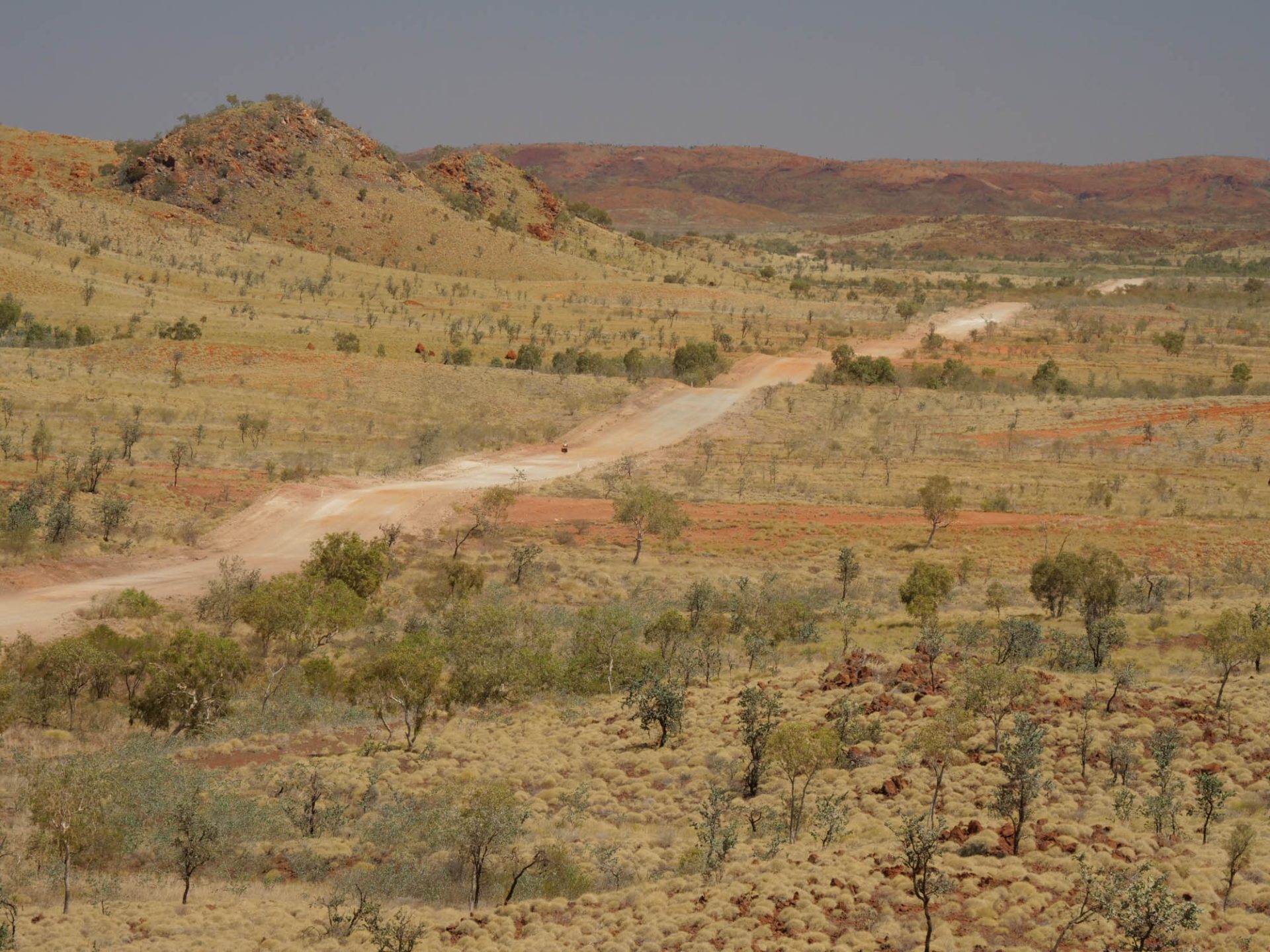
IT: So New Zealand, South America, and then are you going up South America all the way to Canada? What’s the route that you’re planning on taking?
NH: We’ll land in Lima, Peru and head south from there, sticking on the western side. And the plan is to go up in the mountains and head over to Bolivia, Argentina, and then down through Chile. We will see how far we get. So I mean, there’s lots of unknowns for us, how it will go actually travelling with the kids at high altitudes. But from what we’ve been able to research, it’s pretty amazing riding territory through there …
AH: Yeah, incredible. And then South America, you know, that that’s probably the best part of this year and into early next year. And then we would be aiming to go to Europe, around February, March next year, and spend three, three and a half months in Europe, across to Turkey.
And then it gets very difficult to know exactly, but somehow get through those Central Asian states – the Stans – into northern Pakistan, across India, and somehow through Southeast Asia. But we’ve got a couple of difficult political patches in there at the moment, and time will tell whether that’s doable, or whether we need to reorganise the trip completely to get back to Australia.
It’s all by bike as much as possible, but we won’t be shy of catching the odd train, plane, if we need to get across difficult patches or politically unstable areas.
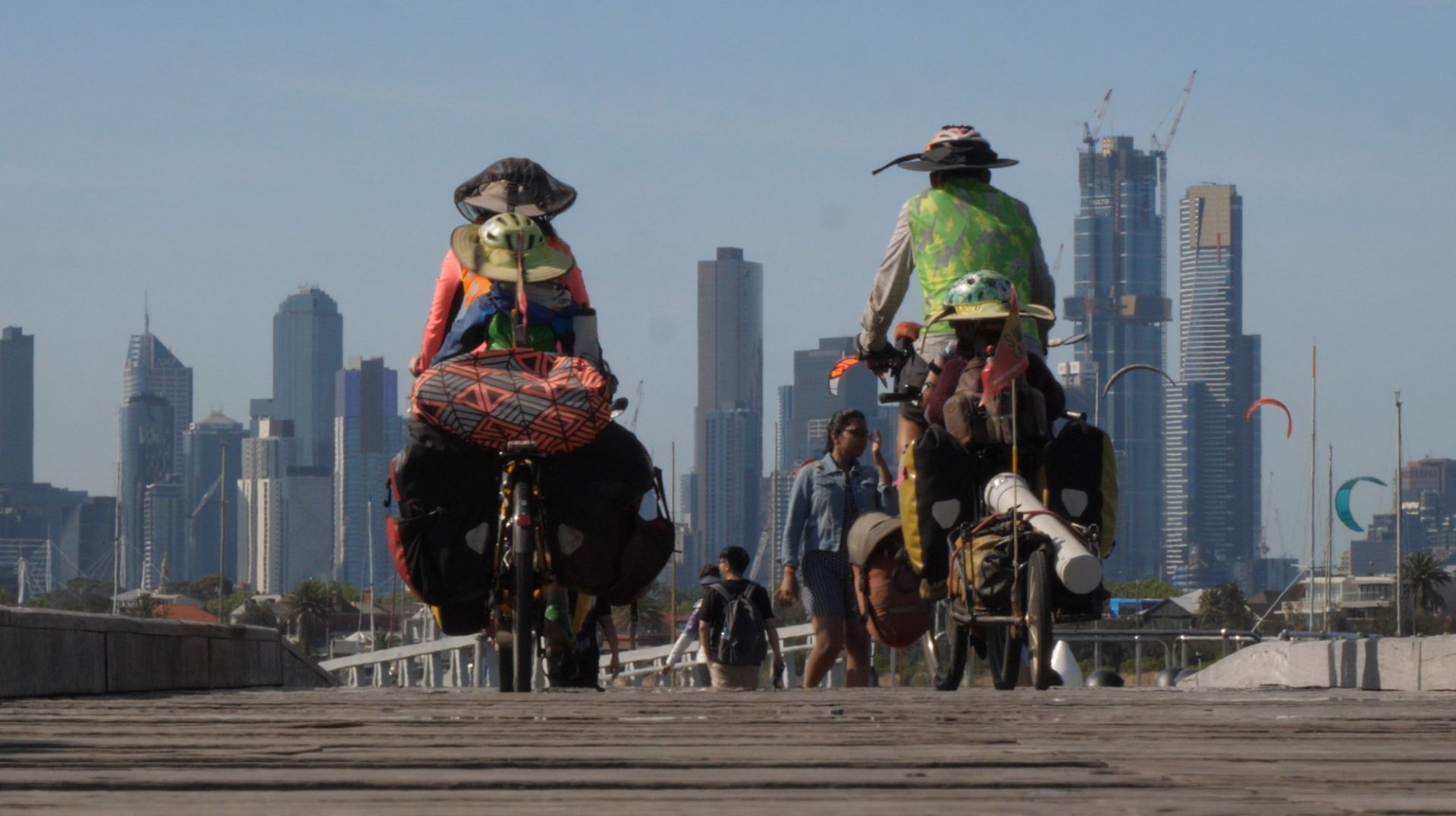
IT: Do you have a rough estimate of when you expect that you’ll be back home?
NH: I mean, roughly, we think it might take us three years. But, you know, it sort of depends on which way we go. But we’re allowing ourselves three years.
IT: When you’re travelling with kids – speaking as a parent who has not tried to ride with my children around the world, or around Australia, or even much beyond the suburb, really – but when you’re travelling with kids, you need to recalibrate your expectations of distance travelled, pack loads of snacks, all that kind of stuff. How do you navigate those kind of things? Are your children just really resilient because they’ve done this kind of thing before? How do you work through those challenges?
AH: There’s a bit of everything you said. So there’s certainly your distance travelled – we’re aiming for about 30 kilometres a day on travel days. So, that’s probably a third of what most bike tourers would be sort of looking at it, half to a third. So that’s the first thing.
You don’t get an early start in the morning – you’re not going to be up at six o’clock and on the road by 6.30. That’s a big one. So you just reset the expectations on how far you will get and things will be a lot smoother. And regular stopping is probably the other thing that most bike tourers don’t do very much. When I’ve done it and Nic’s done it solo, when you stop, you stop and you rest, and you’re relaxed, and you do your fun things. So with kids you might be stopping every 15 or 20 minutes for some reason or another. And so that’s important to set those expectations.

Other than that, bike travel is actually really entertaining for kids. And I think that surprised us. They were really happy to be on the bikes for quite long periods of the day, just having conversations … ours were three and five, but they still loved to talk to their parents and to each other.
They were constantly entertained by what was going on around them, whether it was us, or each other, or the passing scenery, or the people that would stop on the road and have a chat to us, or the rest breaks where they’d find random things in the bush or on the side of the road. So it wasn’t as hard to entertain kids when we were riding as you might think. I don’t know if that contributed to a level of travel happiness, but we never really struggled with that side of it.
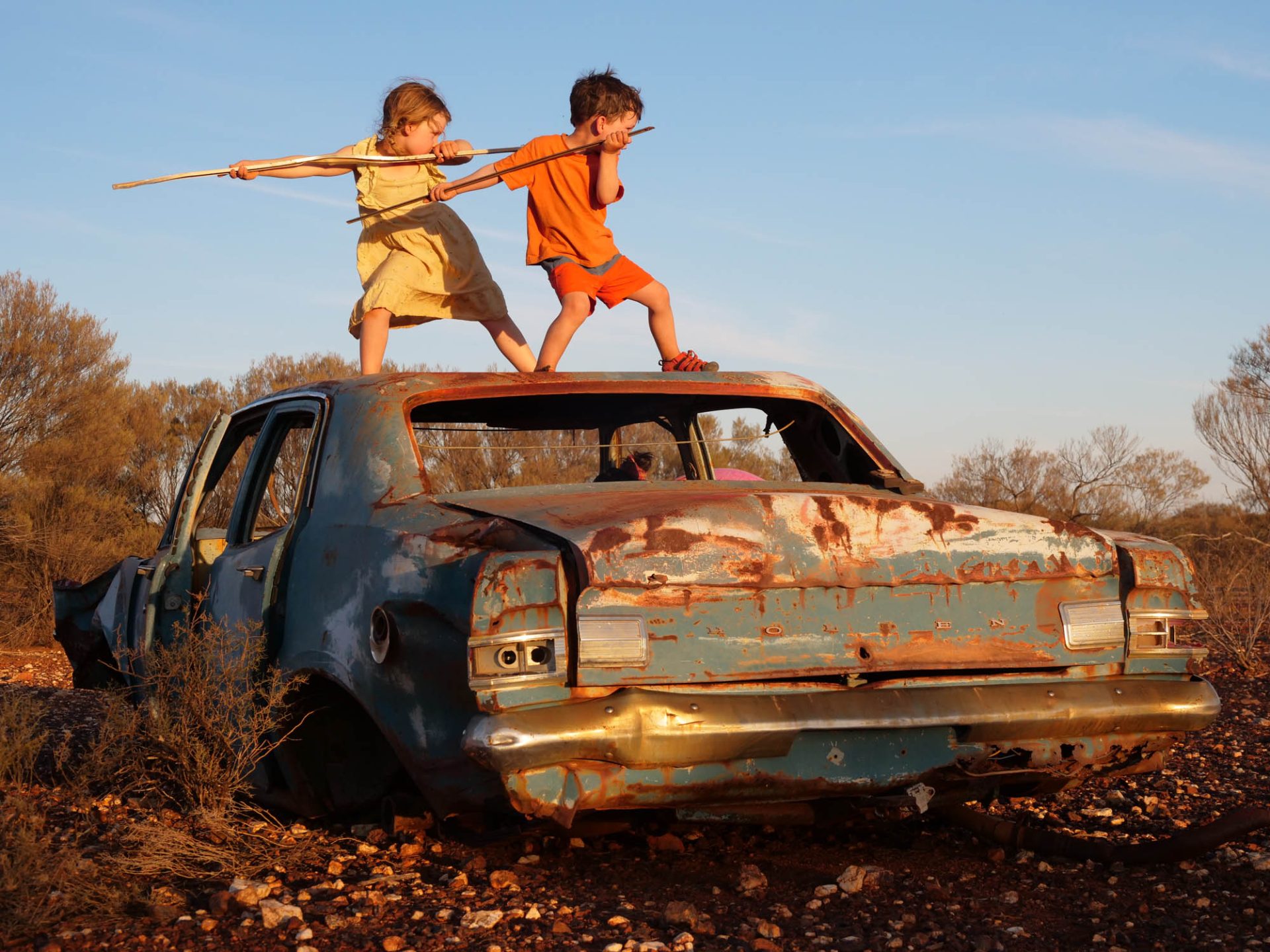
NH: I mean, it was interesting because it gave us a lot of time to get to know the kids and the kids to get to know us as well. I mean, it wasn’t until we got to Broome, I think, that we bought little speakers and then we started to bring in podcasts on the Australia trip. It was so hot that we were actually quite tired of reliving our past life stories. But it added this beautiful element of getting to know each other.
I think probably one of the big things that we keep coming back to is, you know, you have those really hard days at home where you try and get kids off to this, that, and everything else. They’re tired, they’re crabby, they’re grumpy. And that’s every day at home. You know, you’re still having to deal with that on the road but it’s just a different location. It’s not that those things change or they necessarily intensify when you’re on the road; it’s just you’re dealing with it in a different setting.
IT: That’s a good way of explaining it.
AH: We just take the normal parenthood dramas and we’re travelling with them, rather than being stuck at home with them. [laughs]

IT: You mentioned that you settled into this life on the road, and it was this chance to get to know the kids and connect in this meaningful way – what was the decompression process like once you returned to, quote unquote, normal life?
NH: Hmm, actually for us, it was a really interesting time that we came back at, because we came back at the end of 2019, rolled into summer holidays, which was quite nice …
AH: … we had our house rented out, and we let the tenants stay in there for a bit longer while they were finding somewhere to live. So we actually bought a big tent and lived on my brother’s – he’s got a vineyard, like a farming property – so we lived in a big tent for a couple of months, and then, it was COVID. So when we moved back into our place, everyone went into lockdown. So we all … I don’t think we suffered through it. I think we actually had a really positive experience, despite what was going on around us.
NH: And it was actually – I mean, it was a terrible situation for so many people, COVID – but for us, it gave us an opportunity to just slowly reenter into society. Because I can imagine without that self-imposed isolation, it would have been very challenging. And we got little glimpses of that before COVID here and went, “Oh, life’s really busy – I quite like the slow pace of life,” and trying not to create those hectic schedules.
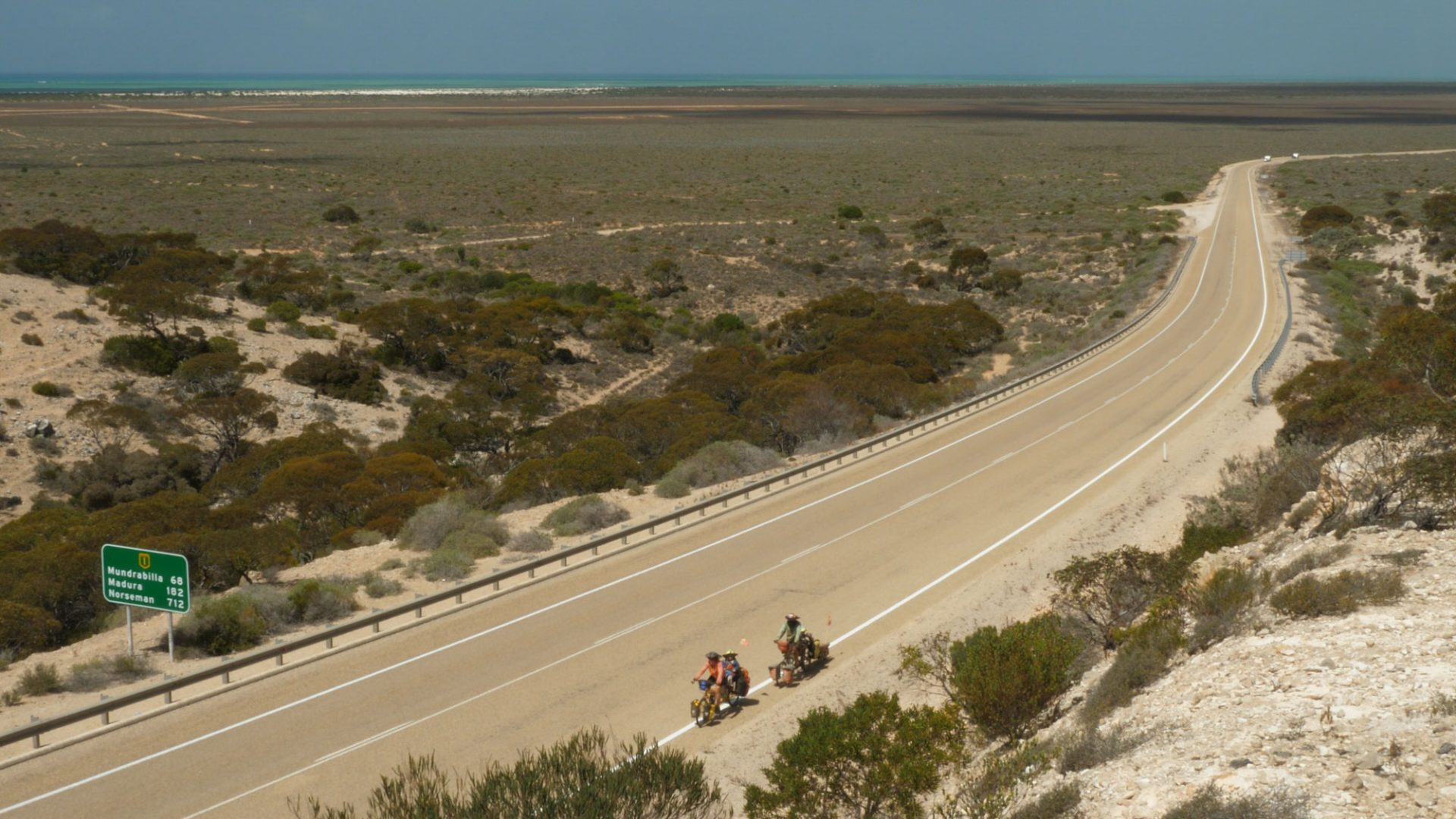
IT: With Hope and Wilfy – they didn’t have a conventional sort of educational setting when they were three and five. And now when you’re going out again, Hope’s 10… So there’s some level of integration into a mainstream educational setting. What challenges does that present for the next three years? And how are you going to navigate those?
AH: It’s a good question. She’s a different age, and Wilfy’s older as well. We’ve been, I think, very lucky that they’re both very centred and calm kids. We also threw them into Far North Queensland, a very small community … we were teaching up there a couple of years ago. So they’ve actually had a year on bike, a disrupted year with COVID at school, a year in a small Aboriginal school in far north Queensland. And then a couple years back at a normal school, and now we’re off again to do basically homeschooling on the bike.
They haven’t really missed a beat – they’re doing fine. So we’re not too worried about about them and their social emotional development.
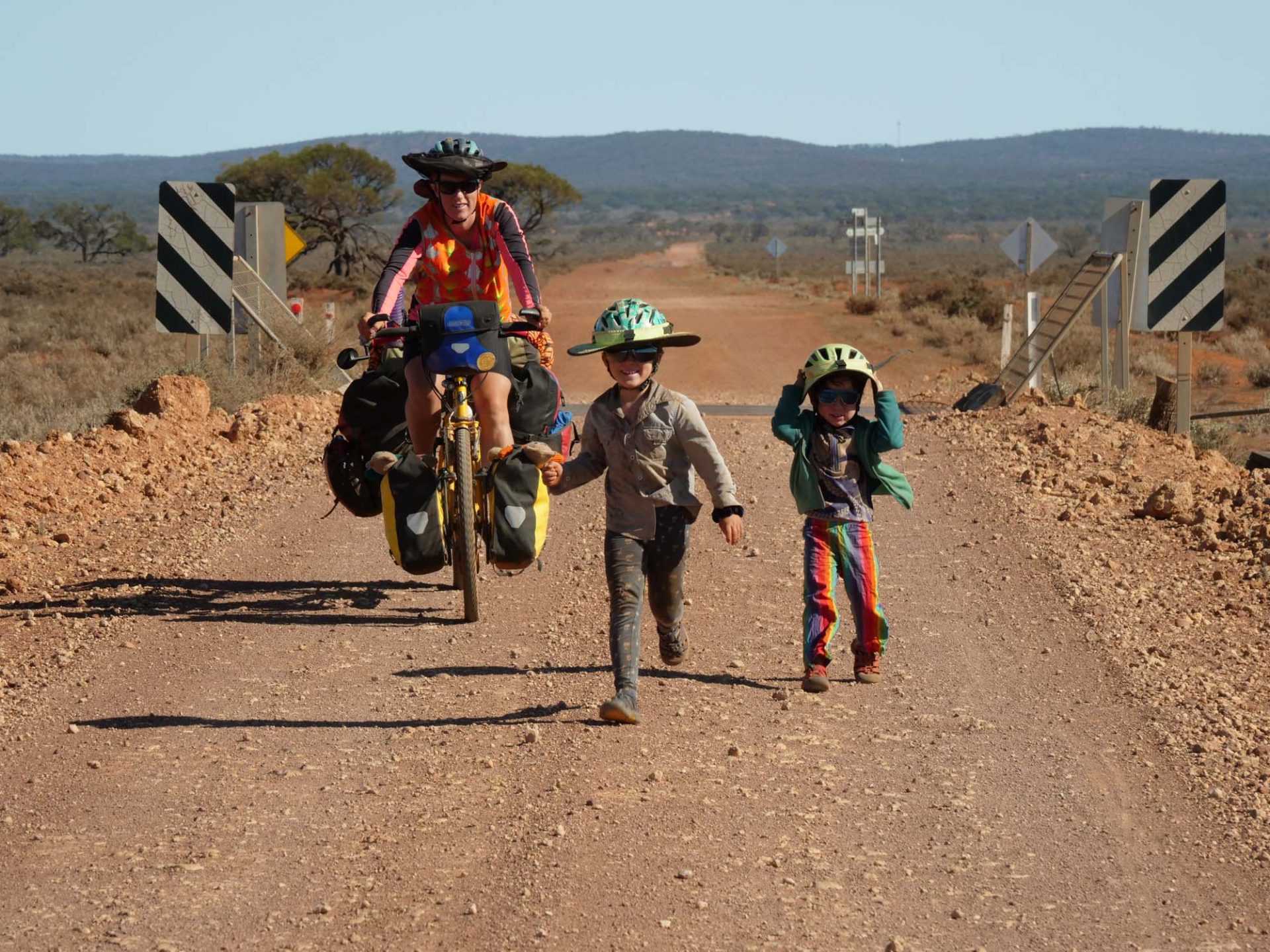
What we’re probably more thinking about is how to keep their academic skills to a point where they can reenter seamlessly back to the mainstream public school back here in Tasmania. So that’s really maths, English, science, and the core curriculum subjects, and just making sure that we’re up to the Australian Curriculum Standards for them, so that they’re not disadvantaged and they don’t feel like they’re separate from their peers. That’s something we’ll work on daily when we’re away. And we’ll be giving them every opportunity to achieve the same sorts of standards as their peers, even though we’re doing it on the road in probably a far more compressed time.
So we think about it a lot. It’s something where, if our kids turned around and said, “We’ve had enough of this, Mum and Dad, we want to go home and be with our mates,” then we will do that.
NH: Life on the road actually presents lots of opportunities for learning across the curriculum. And it’s real life, engaging learning. I think that’s actually the exciting part of it. There’s a lot of opportunity to talk and have conversations whilst you’re on the bike and work through things. But that’s also, you know, the different style of travel that we’ll be doing.
We might ride for a couple of hours in the morning and then we’ll park up whilst Jeannie has a sleep and then you’ve got time to actually do designated schoolwork as well.

IT: And there’s also all of the cultural interaction, expanding an understanding beyond just an Australian suburb or town.
NH: Oh, definitely. And that’s the incredible education that they’re going to get on the road. It’s far beyond what they could have learned in the classroom.
IT: The way that you’re talking about education and curriculum and these kinds of things – it’s obviously something that you’re quite mindful of. But there’s also an educational component on your website. Are either of you educators or teachers?
AH: Yeah, yeah. So I’m a primary school-trained teacher and Nic’s a high school-trained teacher. We’ve both worked in schools for most of our careers. We’ve had other jobs, but basically, we’re teachers.
NH: Yeah, the last, probably 15 years now, Andrew and then more recently me have been running Adventure Learning Projects, where Andrew historically has gone out on an adventure, and then when we did the the Australia trip, we both went out on it. And primary school classrooms follow that adventure. Through units of work and engagement with resources that are created on the trip, be it video clips, or stories or photos … we use the adventure as the hook into the curriculum for teachers.
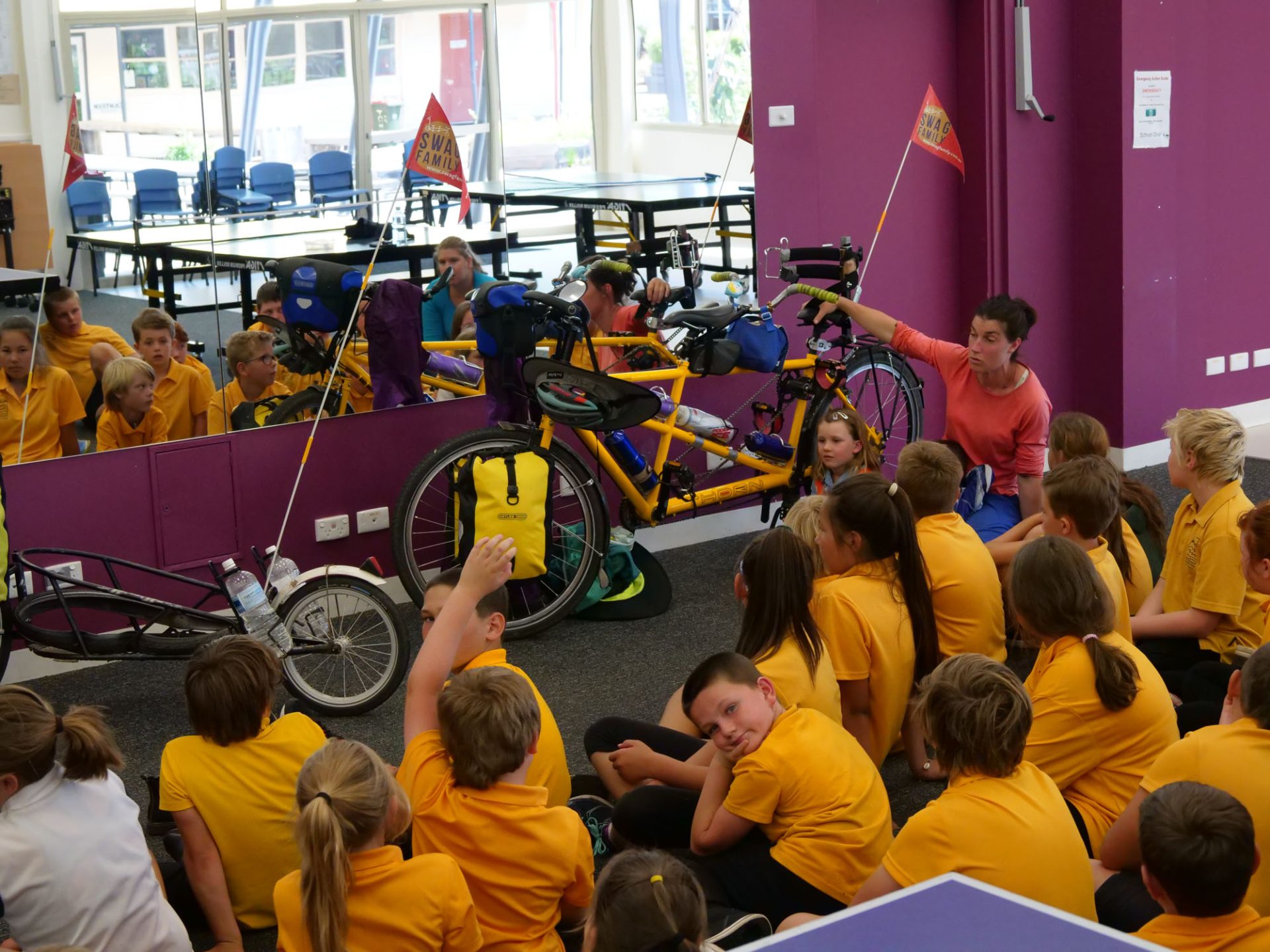
IT: Nicola, you mentioned that Andrew’s been on these adventures before – is this something that both of you have had sort of running in your blood, been doing this kind of stuff for years touring and exploring? Or is this something that is relatively recent, for both of you?
AH: No, it’s a lifelong thing. I grew up in Northwest Tasmania, doing a lot of bushwalking with the family, and that turned into late teens really early solo bike trips. So I’d ridden across the Nullarbor by the time I was 20, and up to Queensland, and then at 21 I rode around Australia, for the first time on a cheap Kmart bike, paddled up the east coast of Australia in a sea kayak, round Papua New Guinea … and as that was happening, I was also training as a teacher and thinking, “Kids love this sort of stuff. They love real life adventure. So how can we turn this thing that I love doing into something that kids can benefit from, and teachers can get a bit of an easier way to hook into their curriculum lessons?”
So we developed – not just me, but also people around me, developed Adventure Learning Projects way back in my early to mid-20s. So it’s been 20 years really of doing Adventure Learning Projects, combined with classroom teaching. So yeah, it’s nothing new. And Nicola’s the same. She had a more conventional teaching background, but she’s also been travelling around Europe on a bike, and done lots of great bushwalking and outdoor adventures …
NH: It’s probably nearly eight years I worked as an outdoor ed teacher. And prior to that I was an outdoor guide and working with school groups. And I saw the excitement from engaging with adventure, and the outdoors.
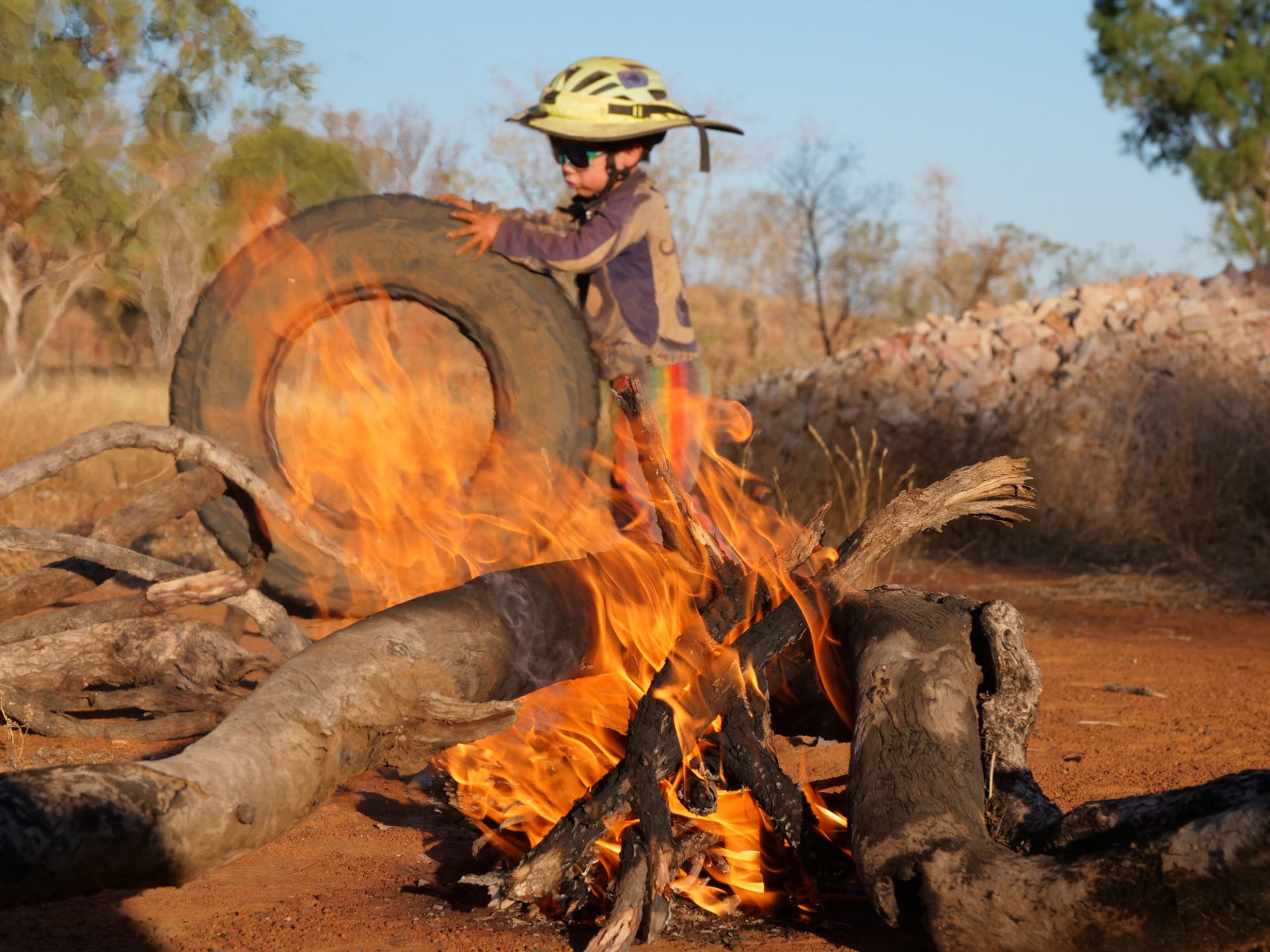
IT: And when you had children of your own, was it just something that you knew you’d introduce them to? That was how you were going to explore the world with them?
NH: Yeah, there was a little hiatus in particular for me, I was still working as an outdoor ed teacher. But, you know, whilst we had the two kids, you know, there was a pause for me but Andrew did some bits and pieces and continued with his Adventure Learning Projects. But when Wilfy must have been one, one and a half, we both sat down on the couch and said, “Right, what are we doing? How do we want to set the foundations for our kids?” And we both knew and came to the conclusion that it was time for a family adventure. That’s where we came up with the Australia bike ride.
IT: Now that they’re a bit older, how do they feel about the trip? Are they excited? Is it a return to a fondly-remembered time for them, or is it a little bit of fear of the unknown?
AH: Well, they were very young. They have memories, and certainly, they have a very strong association with their identity through the trip, which is really interesting … it’s given them a lot of confidence, I think, that this world trip is just the next step for them.
I think they have no idea how challenging it’s going to be at times, even though we’ve tried to prepare them for that, and we’ve given them lots of options for how to get out, I suppose. But they’re very keen. They’re very, very enthusiastic about this trip to the point where if we even jokingly say, “Oh, well, we’ll just can that idea and we’ll do something else,” they get quite upset about that.
NH: I had that conversation with them separately in the car one day – because I was just keen to know what their reaction would be – and I said, “What would you say if we decided we’re not going to do the trip anymore?” And oh, my goodness, their faces dropped. And they said, What? We’re not doing the trip?” “No, no, no, I’m just wondering what you would say,” I said. “Of course, we’re doing the trip.” And they were like, “Oh, thank goodness, we’re really excited. I want to go on the trip!”
AH: We’ve brainwashed them completely. [laughs]

IT: In terms of logistics, do you carry everything you need with you throughout, or do you mail things ahead? Do you stay and stop somewhere for a stretch, sort of settling in a community for a little while, and then keep going?
AH: It’ll probably be like the Australia trip, that we won’t stop for long anywhere. We may, but traditionally, two or three days is sort of the maximum, or enough time to really gather food, re-energise the batteries, get everything all fixed up, and then we’re off again. That constant travel is certainly a hallmark of how we’ve both done our trips in the past, so that’s what we’re planning to do.
We carry tents, sleeping bags, sleep mats, cooking gear, food and water … food, you can carry probably a week before it gets pretty onerously heavy, and water probably two or three days. So that’s your limit, where you need to find resupply, which could be a wild river or a creek if it’s that sort of country, or it could be that you send a water drop up the road with a friendly motorist that’s going the same way.

But the only things we’ll send ahead will be some specialised gear for Jeannie when she graduates from a baby seat, which we’ve currently got on the bike, to kiddie cranks on the back, because that’s a sort of cage retainer for her and the kiddie cranks themselves, we’re not keen to carry them for the next year while she’s not using them.
But otherwise, no, we’re pretty self-contained. We’ll wear gear out in the next 12 months, we’ll be constantly replacing things, but we won’t be sending things ahead, particularly, no.
IT: I guess with New Zealand up first, that’s a relatively sort of familiar entry into things. But the further you go off the beaten track, I imagine you’ll start running into more remote places where you may not be able to communicate with the locals, and you won’t have easy access to bike parts or whatever. How do you expect that those kinds of situations might present difficulties for you?
NH: Well, we carry basic first aid kits, and we’ve got the tools to fix up chains and brakes and bits and pieces … So, you know, barring things catastrophically going wrong, we can fix up most situations. And I suppose that’s also part of the adventure.
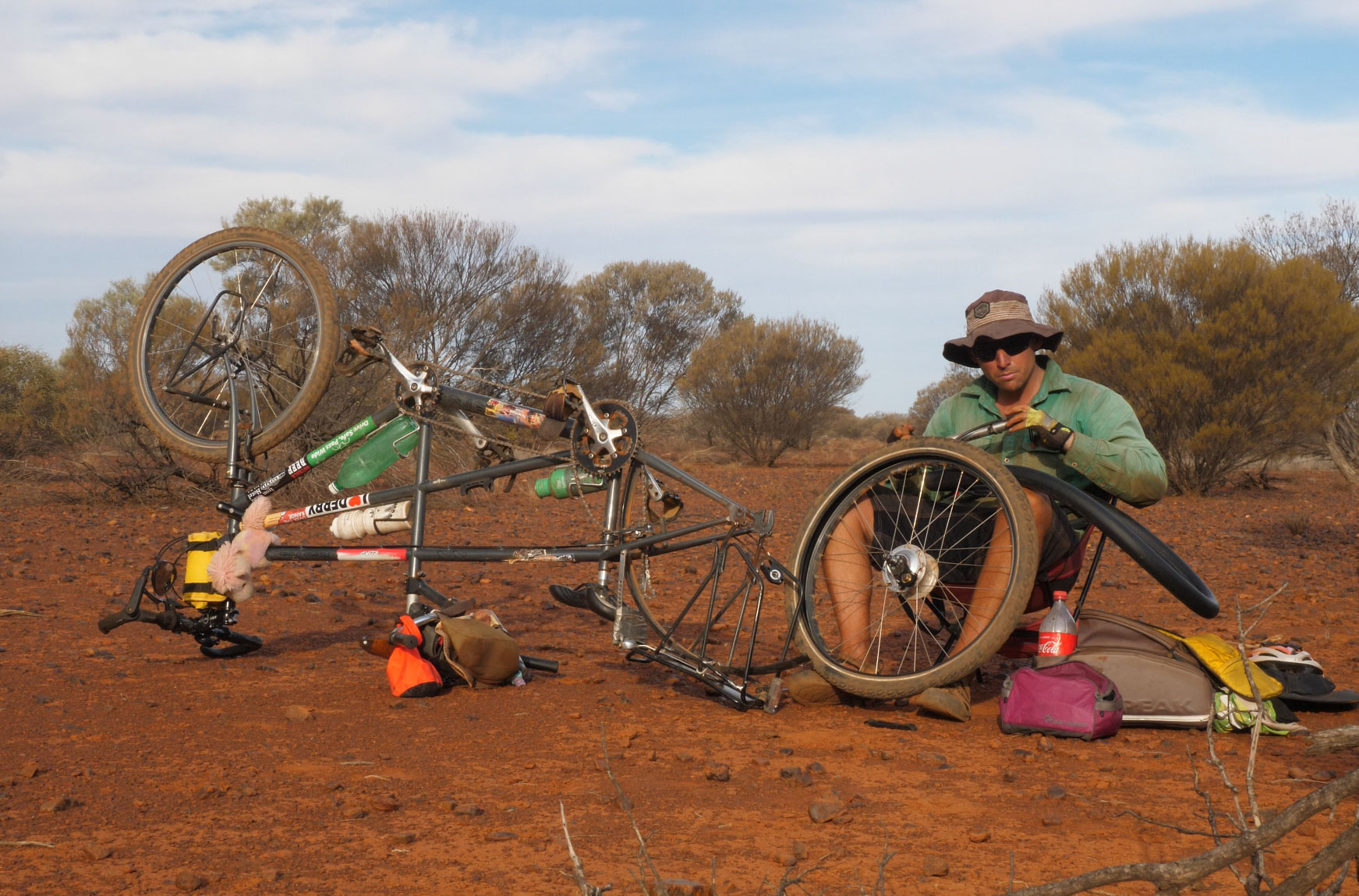
If something really goes wrong, and your frame’s busted or whatever, then you actually have to figure it out on the road. You can’t necessarily have all the answers before you depart – that planning thing, knowing exactly where you’re going to go, and when you’re going to be there – adventures are full of unknowns and actually about coming through those challenges and problem solving. So that’s part of the exciting bit as well.
AH: And just to add to that – we’ve got really good bikes. I’ve done big trips on really shit bikes, and they break down all the time, and you do get stuck on the side of the road a lot. We’ve invested in some pretty pretty nice bikes from Thorn in the UK, who just make good solid, not bombproof, but they’re very reliable bikes and that’s a big part of the remote-area confidence.
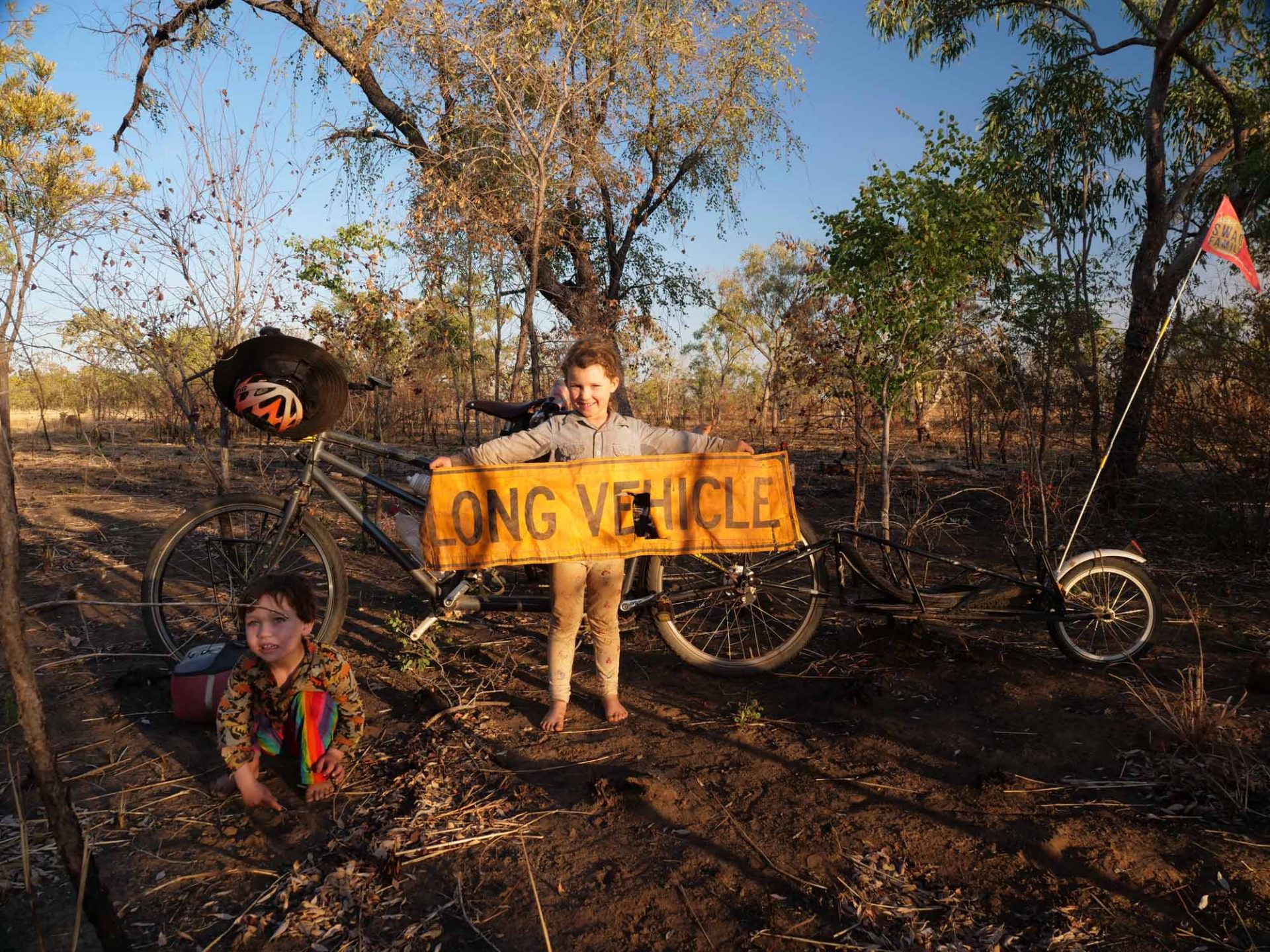
NH: We’ve got great first aid kits …
AH: Yep, we’re both first aid trained. We do have an EPIRB [emergency position indicating radio beacons] just in case it all really goes wrong, and we’ll have local contacts in country, too – we’ll let them know of what we’re doing and to have check ins and bits and pieces. So we’ll have the usual standard safety precautions in place.
But then at the end of the day, like Nic said, if you end up in a place and you need help: in our experience people all over the world are equally welcoming and kind, especially to people that genuinely require help. So we both have confidence that humanity’s going to come through when we really need it – if we really need it. And that fear of the unknown is something you just have to sort of settle and know that, despite all your planning, things can still run off the rails, but there will be a solution.
The beauty of it is you won’t know that until you’re in that situation, and you won’t know how to solve it until you’re presented with the unique challenge of being in a remote place and something going wrong.

IT: It’s an opportunity for personal growth! That’s a really nice answer. And I like that, in your experience, that the kindness of strangers is something that you have been able to rely on. I think you’d maybe expect that people are becoming increasingly polarised and increasingly have negative motivations for what they do and the way they do it, but it’s really comforting to hear that that hasn’t been your experience.
NH: I mean, it was one of the really special things from the Australia trip, the people that we met along the road. We chose to take the back roads, the gravel roads, the remote roads, and it meant that when we came across people, they stopped. And they checked in and they said, you know, “What the heck are you doing out here?” But they also had the time to share stories of who they were and what they were doing.
And it was just, you know, sort of twofold: the acts of kindness, whether it was people gave you a can of Coke, or an icy pole or a frozen steak, but they’d also share part of their life, or they’d invite you into part of their life.
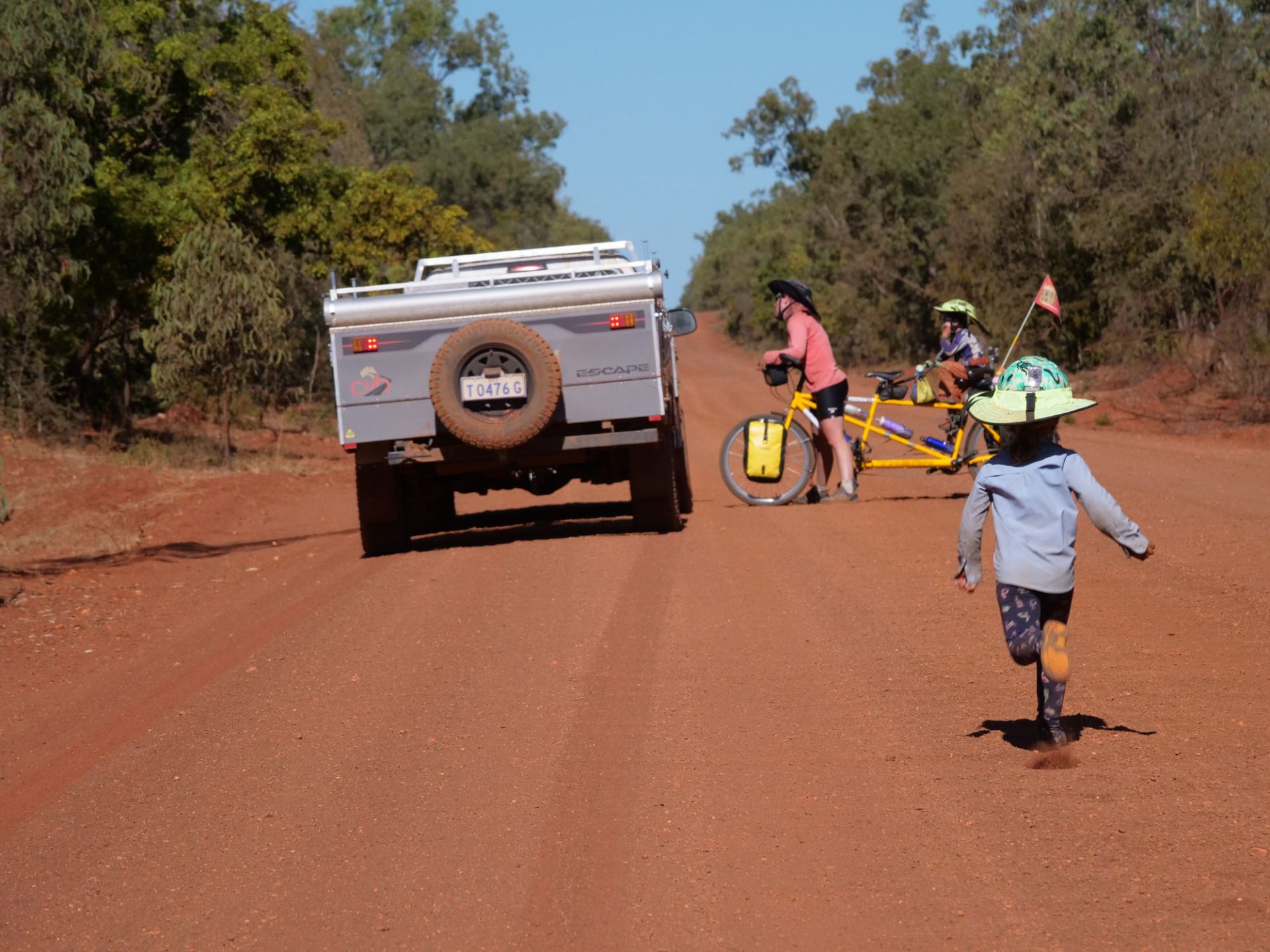
I think had we chosen on that trip to go on the busy highways of the east coast and around the coastal route, you’re just, you know, a person on the bike, and people don’t have time to stop and have a chat, let alone the ability to pull over on a highway. But taking these remote roads and doing the slow travel, particularly as a family, people don’t see you as a threat. Yeah, we’re probably the travelling circus, the roadshow, but it’s an opportunity for people to have that human interaction.
That’s something that we value, and that we really value for our kids to be part of – to actually get to know people from around Australia, from all different walks of life, in different areas, but you know, in particular on this trip, that’s the big thing. We want the kids to get to know different places around the world and people, and the thing that connects us.
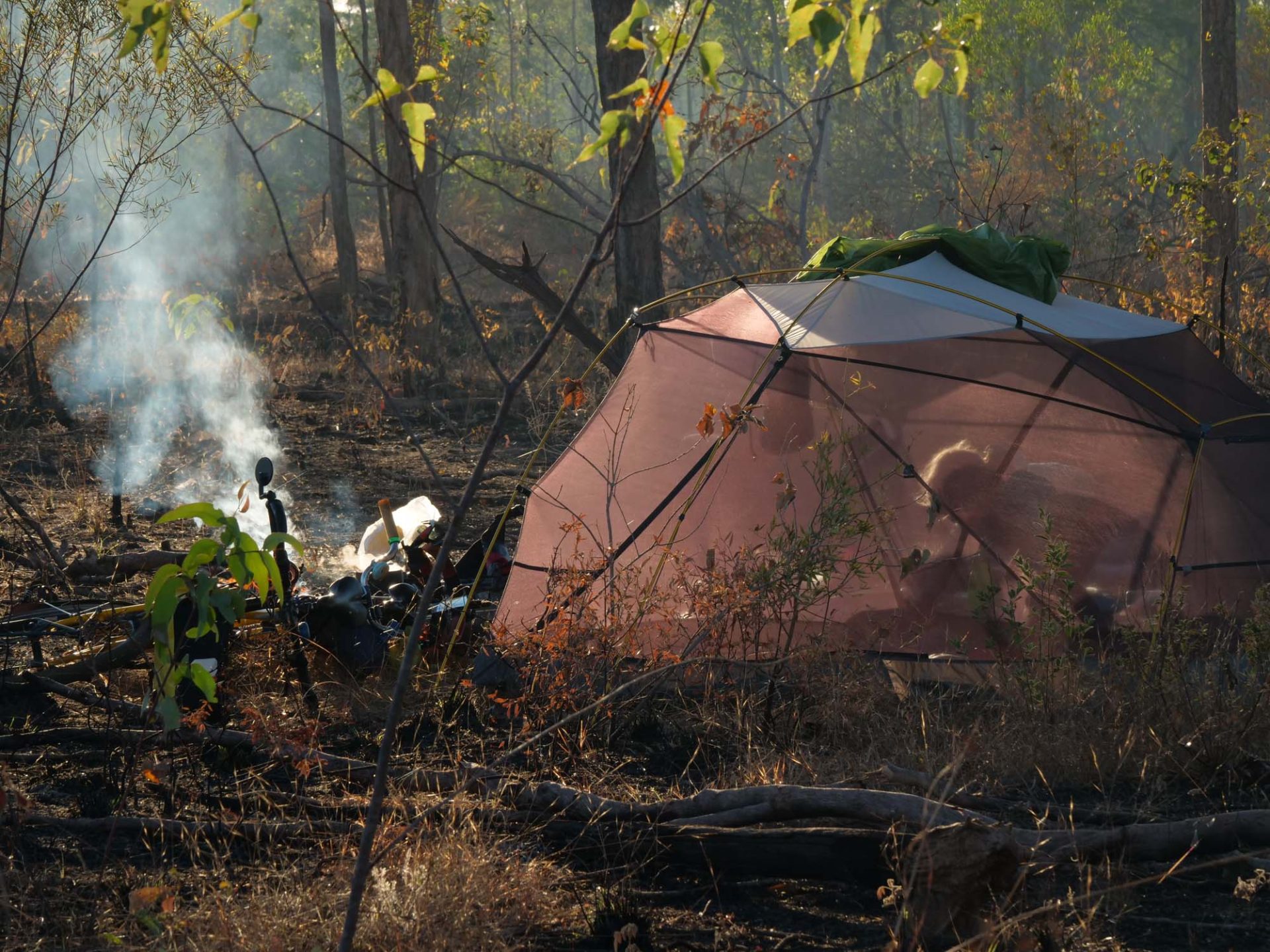
AH: I’ll give you a concrete example of that, Iain. We were on a remote Western Australian road, the trucks have usually got three trailers over there, and the trucks mostly always gave us a wide berth, and we pulled over for them, just to reduce the chance of getting run over. This particular day, this truck drove past, and a couple of minutes later, it came back without the three trailers on it – the truck driver had pulled over, taken his trailers off, turned around, come back, dropped off some water, said “hello’,” turned back around, picked his load back up and got going down the highway.
That’s the sort of thing that happens when you’re in remote areas. And especially, I think, when you’re travelling with the family, it opens up a different set of doors than I saw as a young solo traveller.
IT: Yes, absolutely. I think you’re spot on with that – I ride with my girls in a cargo trike, and the difference in attitudes just on suburban streets to a cyclist in that kind of context versus if I’m wearing Lycra or whatever. It’s a very different experience.
AH: Yeah, yeah. I mean, most touring cyclists have stories of generosity on the road. I think if you’re with kids, you can probably triple that. It’s just incredible how people respond, just seeing especially young kids out doing adventurous things, most people just absolutely love it. They just think, “Wow, that’s something worth celebrating.” It is actually really wonderful to be part of that story with the kids that they can share in that.
They see the best of humanity, when we travel with them, they really do. We feel very lucky to be able to do it.
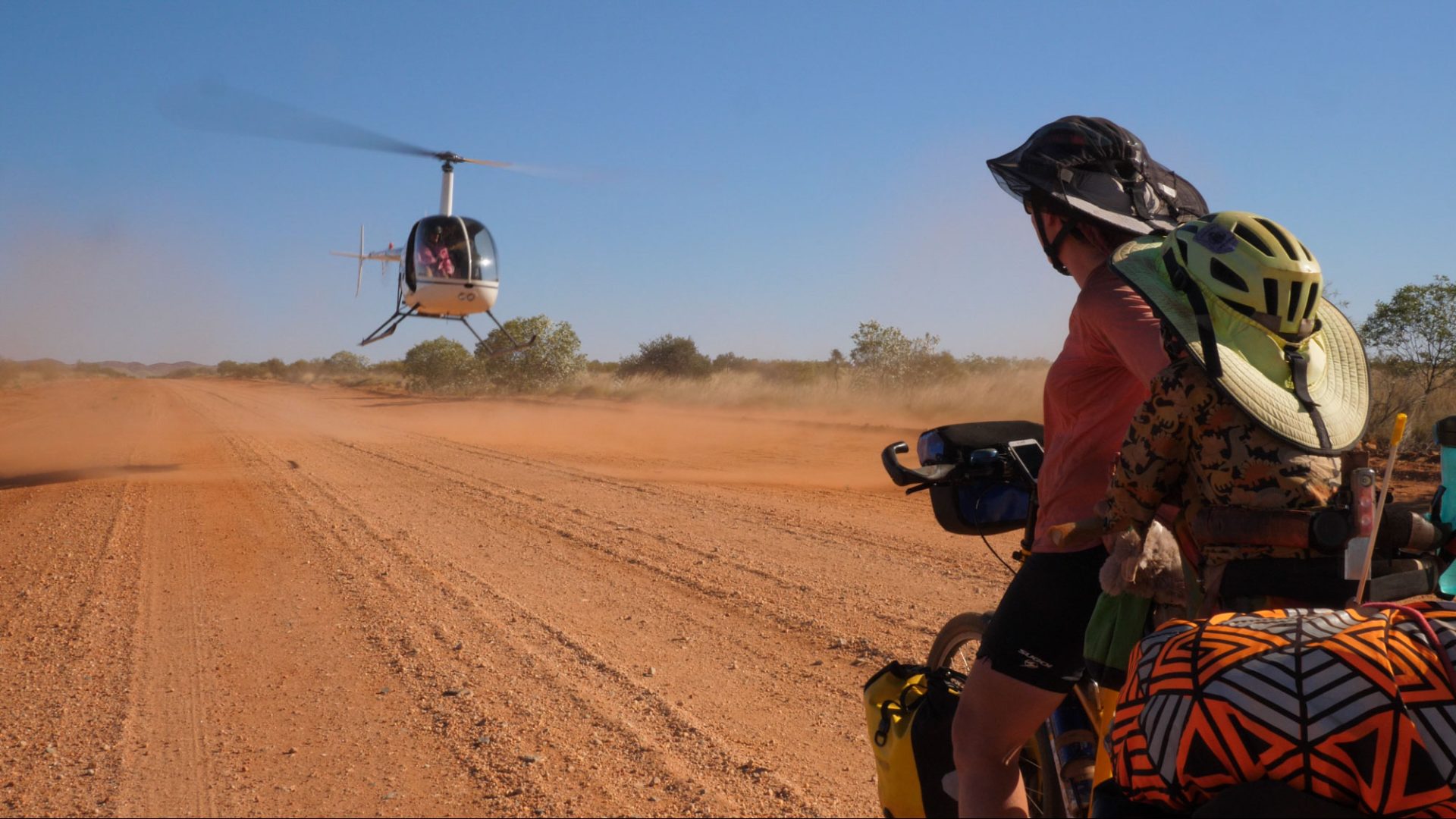
IT: I have two last questions that I’m going to throw at you. The first one is: are there any moments that stand out as having been particularly scary or particularly challenging? And the related second question is, do you have a favourite moment or a most beautiful moment from your travels?
NH: I think from the Australia trip, the hardest thing for us was actually leaving – making the decision to leave, packing up, and dealing with peoples’ thoughts and feelings on what we were doing. We could try and justify it and say that we thought we were doing the right thing as a family and for us, but trying to battle with the background noise …
AH: We didn’t have universal support for the idea of travelling with two little kids around remote Australia. So overcoming those obstacles and pushing through that, that feedback and saying, “We’re gonna do it anyway, because we feel confident in our decision making.” It was a challenge for sure. Probably, Nic’s right, probably the biggest challenge of that trip.
NH: Yeah. And actually, just between dealing with that, and packing up the house and finishing work and having Christmas and planning the trip and getting on the bike, all those things in this sort of melting pot. That was the most challenging part.
This time, it’s actually really lovely. We’re doing it differently. One: we’ve got track record now, laps on the map. But also we’ve packed up our house, ticked that box off, finished work, and we’ve had a month where we’re living at Andrew’s parents and doing the final planning. We’re just totally focused on the bike ride and saying goodbye to some mates.

AH: On the road itself – maybe it’s just because four, five years have passed, but I really only have fond memories of the bike ride itself. The kids, as you would expect, had some major meltdowns along the way. But that was all just part of normal life. On the bike, I don’t think there was … I don’t know, Nic, it was just bloody good.
NH: Yeah, it was. I mean, it was tough. Like, it was really tough at times. But then you get to the end of the day, and just go, “Uff, that’s awesome. We’ve just made it five kays down the road. And I’ve got my cup of tea and sitting by the fire.”
AH: The odd caravan would go past too fast on a dirty road and send dust up our nostrils, and Nic might fall over in a bit of bull dust and the kids would laugh at her. You know, there’s all those bits, but they weren’t bad, and they weren’t overly challenging. They were just part and parcel of any long bike trip.
On the positive, the best bits of the trip… the things we remember the most fondly are the interactions with people in remote areas where we sort of needed more support. Because we didn’t have maybe telephone communication or anything, so whenever someone pulled over in those remote places and offered a hand – whether we were asking for it or not, and we never really put our hand up on the road for help – it was just very special to see that side of Australians. They’re our best memories of that trip, I think.

NH: The one place that sticks in my mind – there’s many, many places, but one in particular – we’d been travelling along the trans access road, which follows the train line that goes from Perth to Sydney. It’s in the middle of nowhere. You leave Kalgoorlie …
AH: Yep, head dead east from Kalgoorlie.
NH: … and we’d been told by lots of people, “Don’t go out that way – there’s nothing out there.” But we talked to the station owner, and they were like, “No, come, we’ve got the largest sheep station in the world, you can cut through our place.” And there’s nothing: it’s limestone track, there’s hardly any vegetation, you might see the occasional sheep.
And I remember getting through a day and a half of that, and we hadn’t seen anybody, and it’s the Nullarbor – it’s flat and isolated and rugged, and we’re sitting around the campfire, and there’s this thunder and lightning storm, and it is just spectacular. We’re the only ones out here and, and just amongst these elements, and with the kids. And it was just such a beautiful, beautiful moment on the bike ride.
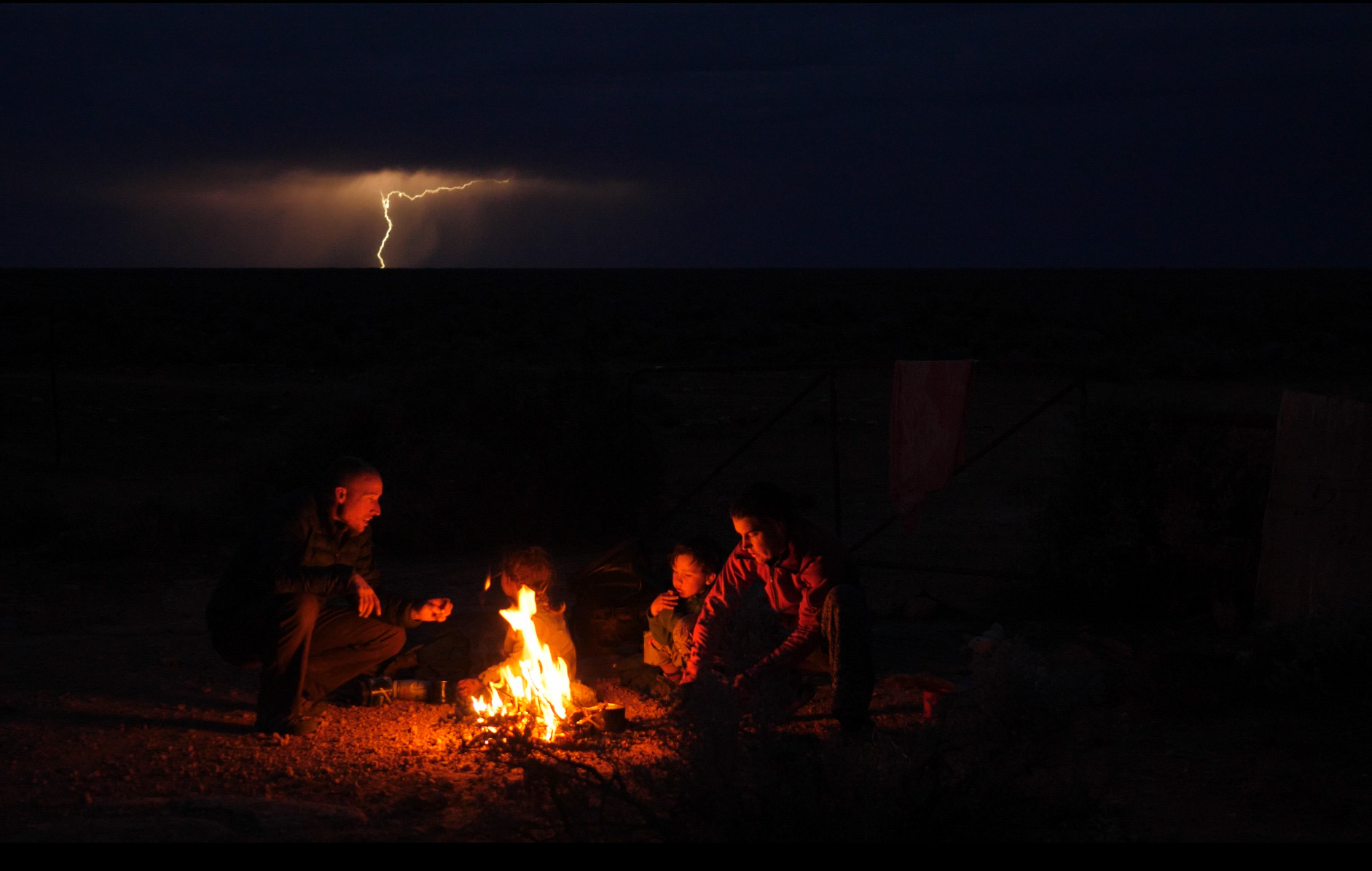
IT: This makes me want to go travelling.
AH: Quit your job and go!
NH: Hey, you can keep your job and still go!
AH: You can bloody write stuff and travel doing that.
Iain Treloar: I’m not sure if I have as much confidence in my abilities as I do in yours. [laughs]
NH: You know what, for us, it’s … you just start slow and know that your gear might not be right, and you might not get very far. But like, as you pedal a little bit further, a little bit further, you learn and you make adjustments, and you figure out what’s going to work for the kids.
And you enter into this rhythm and routine – which actually for us as a family is so much better, and stress-free, compared to what we find that we enter into in everyday life where you’re getting pulled off to this event and this event. Life can get really complicated and stressful. But when you’re on the bike, you’re all going the same direction. And you’re all together.
AH: We’re taking the easy option. [laughs] And you’re taking the hard option.
NH: Get on the bike with the kids!
You can follow the adventures of the Hughes family at their website: swagfamily.au.
Support them and receive content via the family’s Patreon.
Photo Gallery
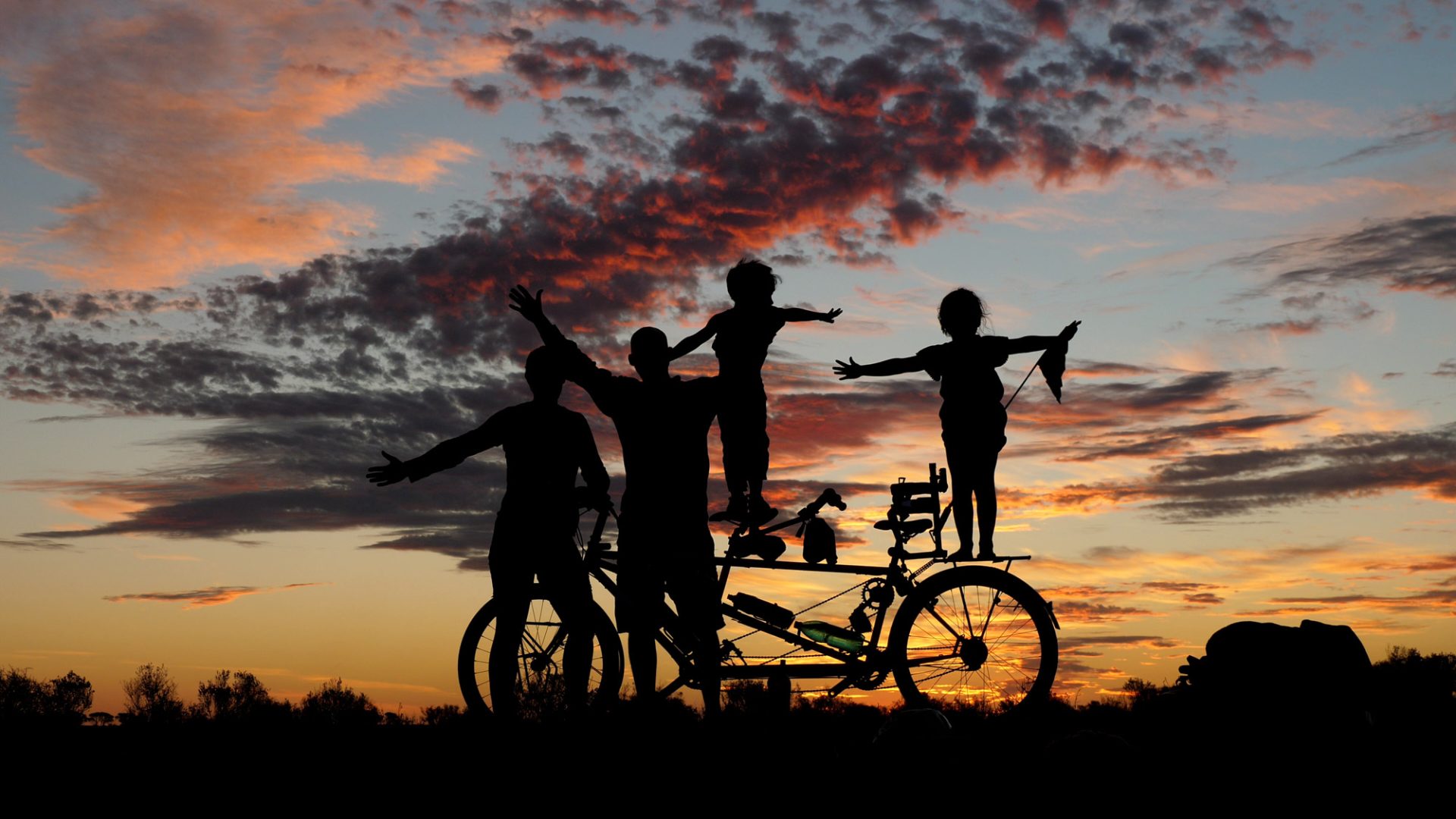



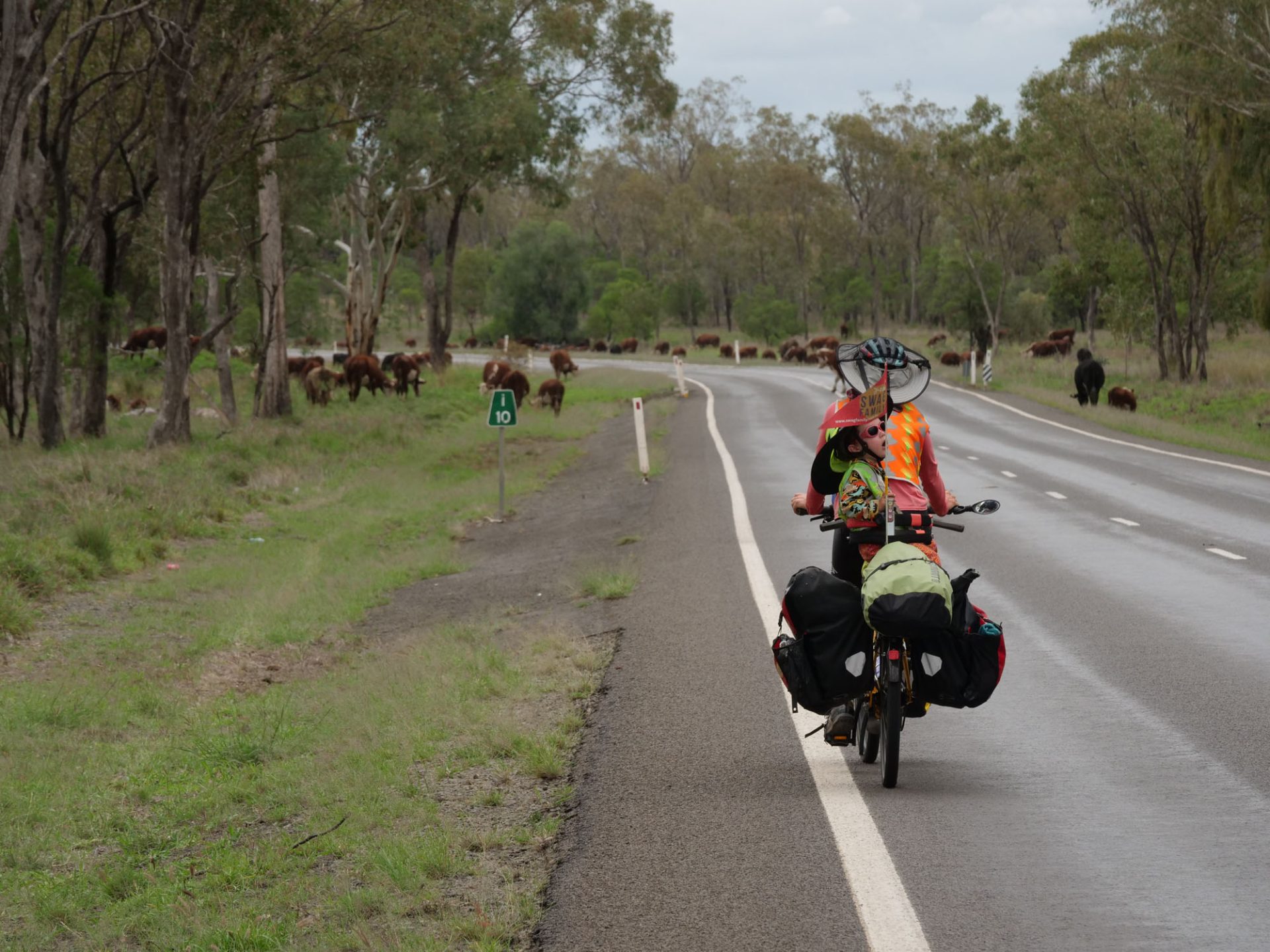


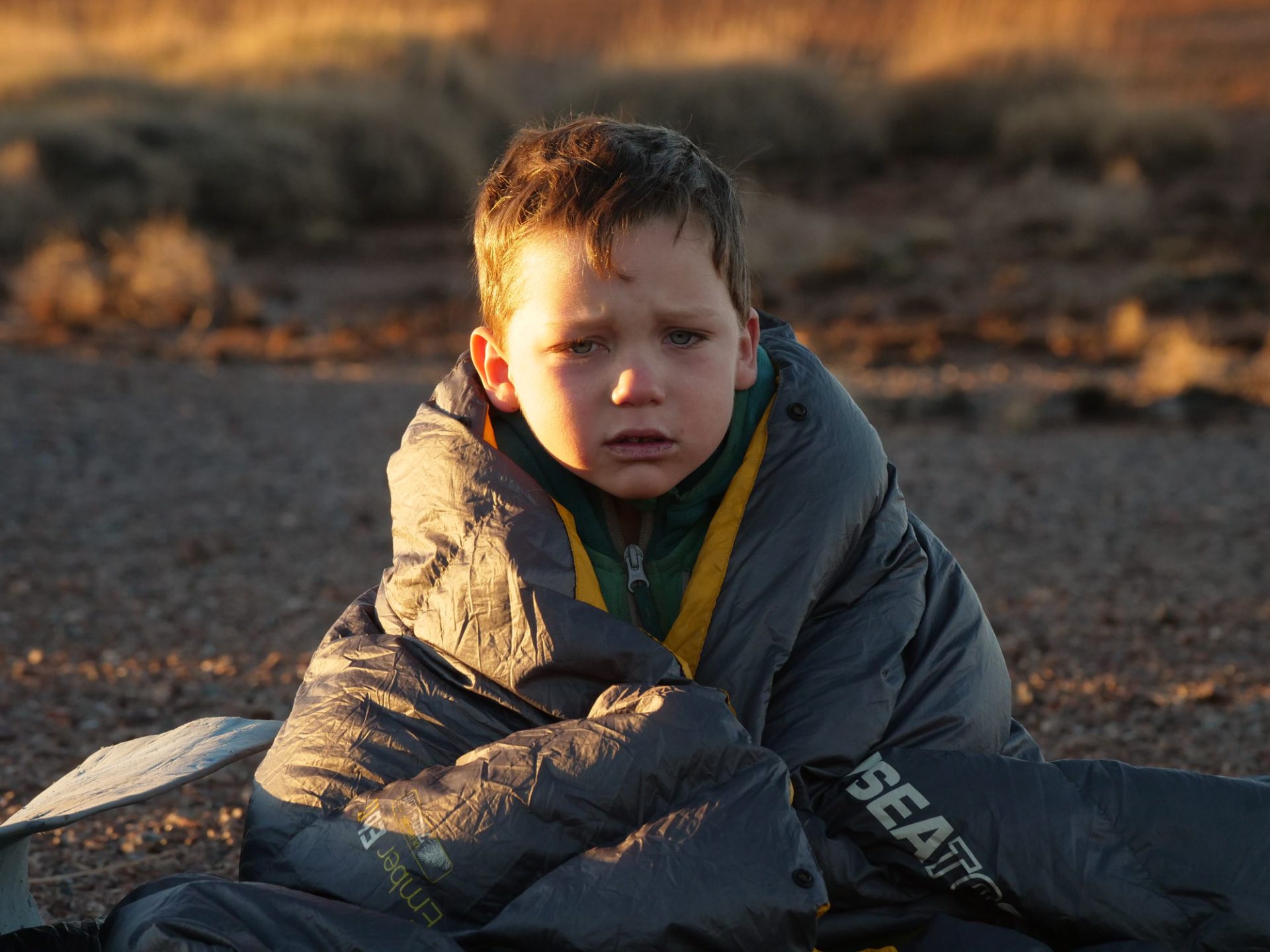
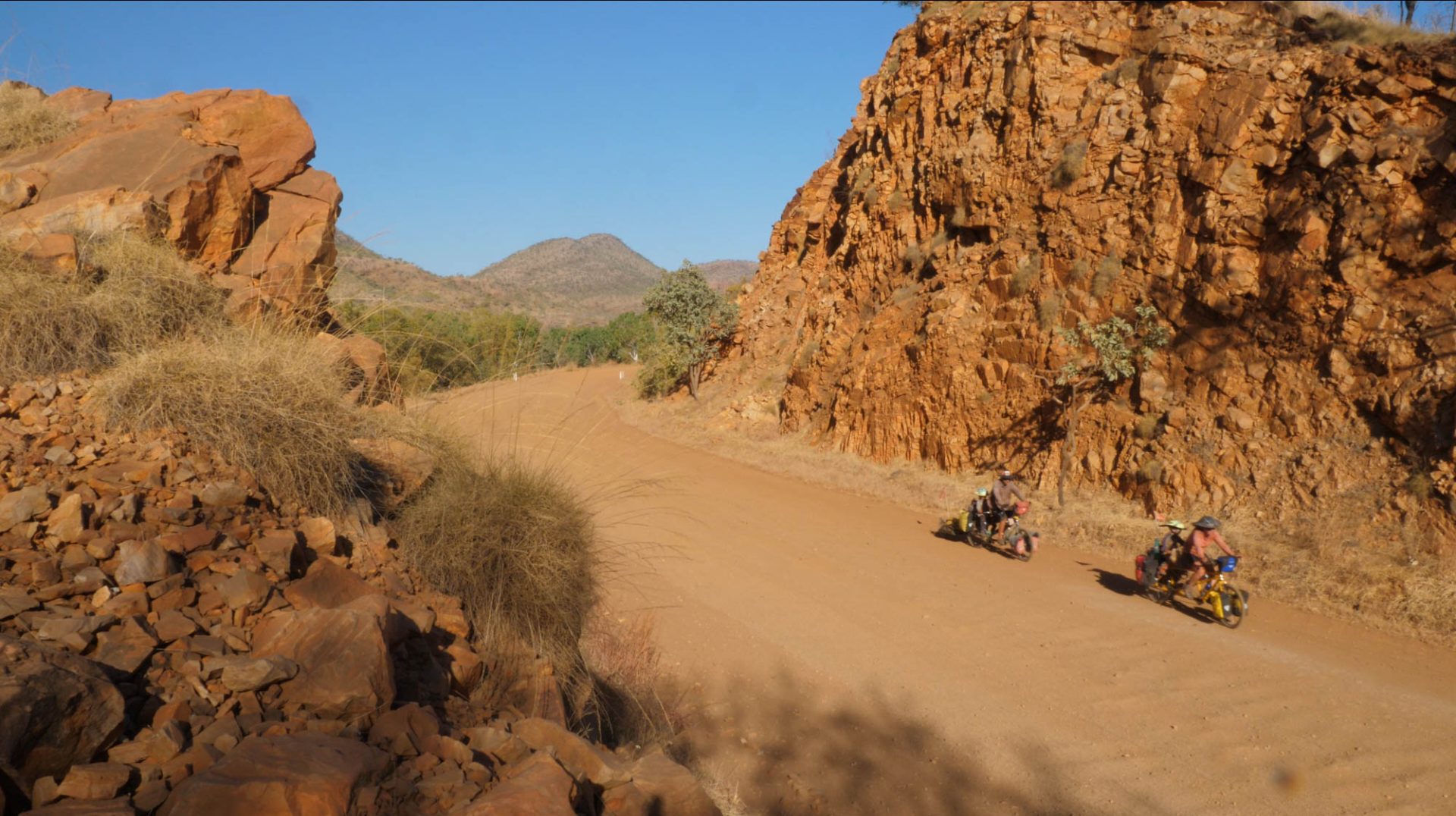

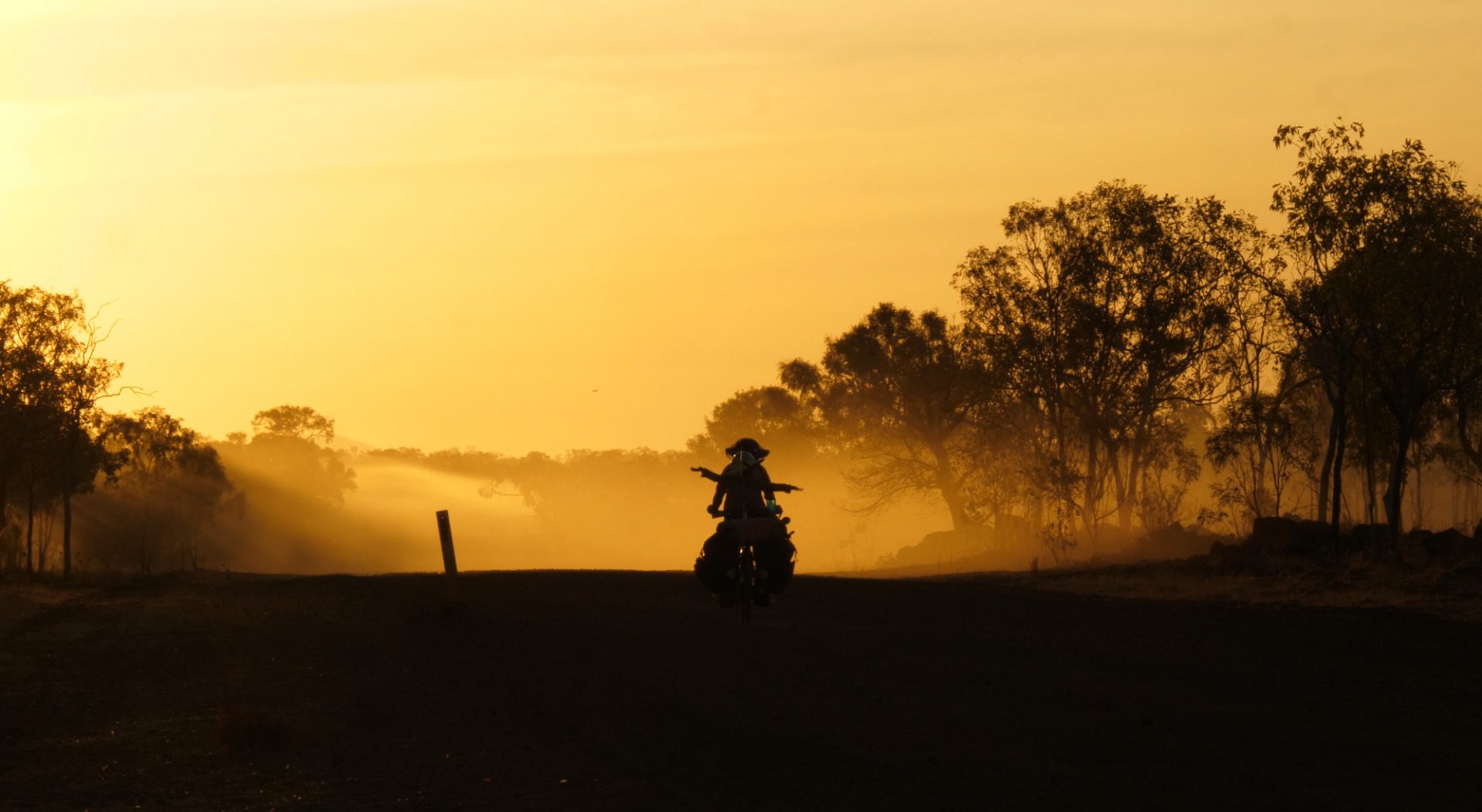
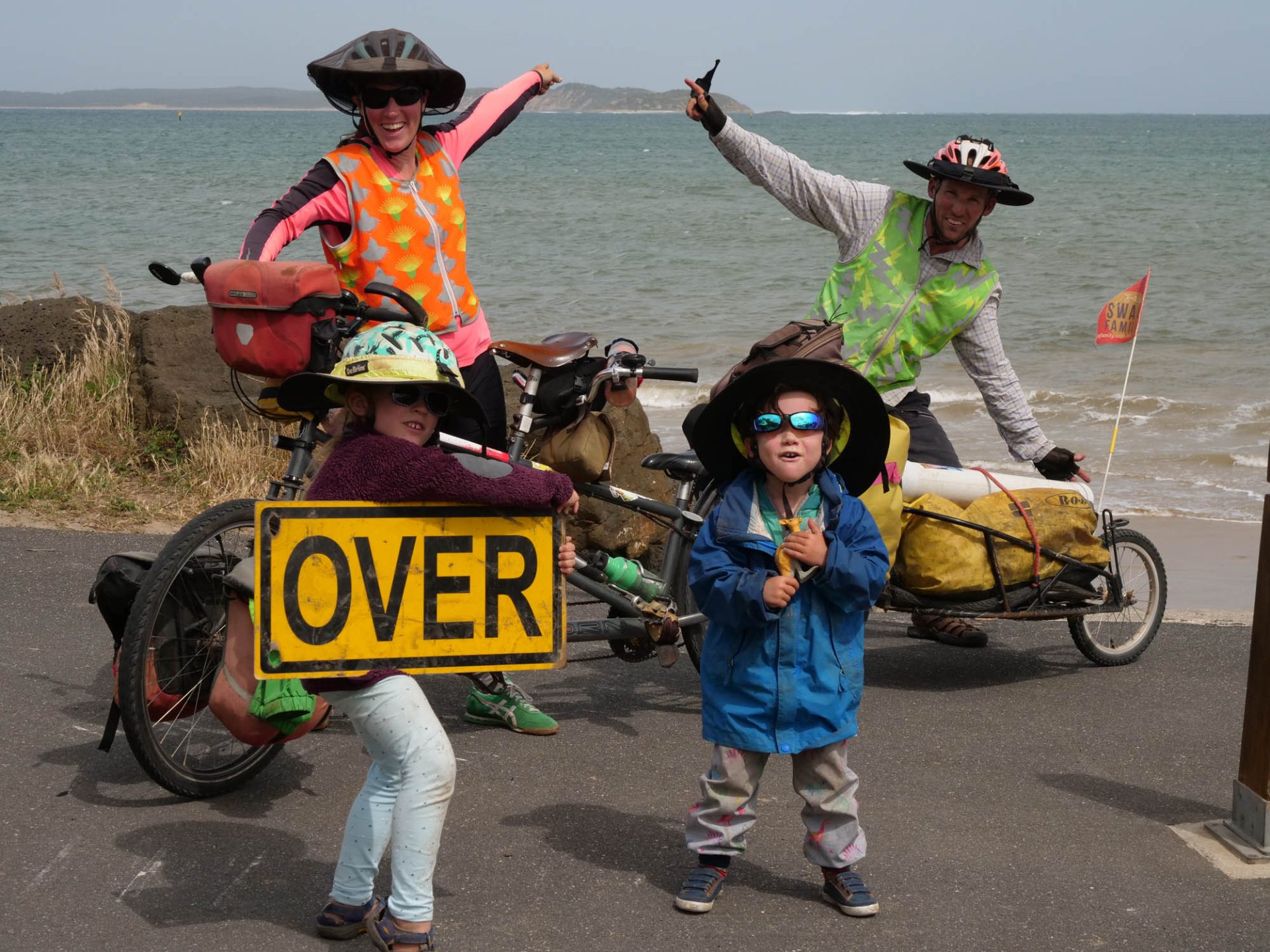
What did you think of this story?

